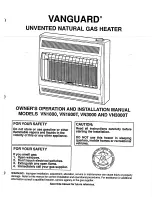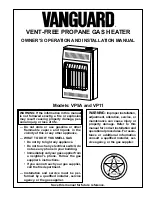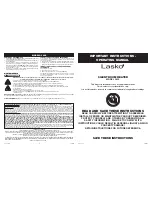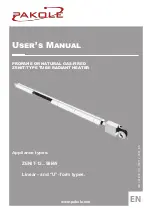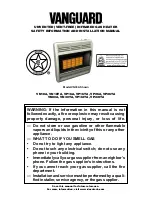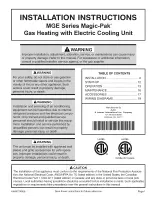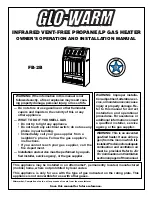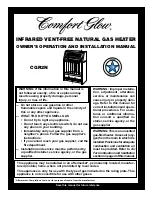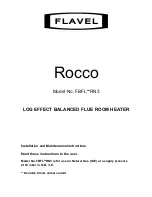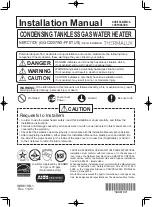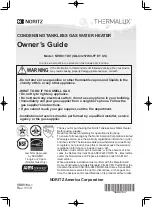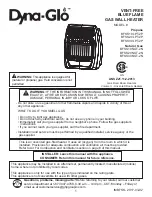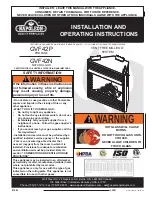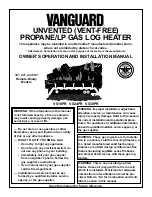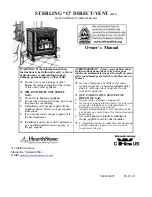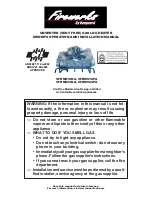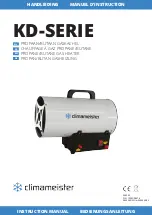
1. Read all safety precautions and follow L. B. White
recommendations when installing this heater. If
during the installation or relocating of heater, you
suspect that a part is damaged or defective, call a
qualified service agency for repair or replacement.
2. Position the heater and its gas supply hose so as to
protect heater and its gas supply hose from livestock.
3. Insure that all accessories that ship within the heater
have been removed from inside of heater and
installed. This pertains to air diverters, hose,
regulators, etc.
4. Make sure heater hangs level (check crosswise and
lengthwise).
5. This heater is approved for indoor use only.
6. The heater is not for use with ductwork.
7. The unit's gas regulator (with pressure relief
valve) should be installed outside of building.
Any regulators inside the buildings must be
properly vented to the outside. Local, state and
national codes always apply to regulator installation.
Natural gas regulators with vent limiting device
may be mounted indoors without venting to out-
doors.
8. It is required in accordance with NFPA 54, Latest
Edition, that a sediment trap be installed at the gas
valve inlet to prevent foreign materials (pipe com-
pound, pipe chips, and scale) from entering gas
valve.
9. It is required in accordance with NFPA 54, Latest
Edition, that gas utilization equipment connected to a
piping system have an accessible, approved manual
shut off valve installed within 6 ft. (1.83M) of the
appliance it serves.
10. Always use pipe joint compound that is resistant to
propane gas and natural gas.
11. Check all connections for gas leaks using leak
detection solution or ammonia free soapy water
solution. The gas leak test is performed as follows:
Paint pipe connections, hose connections, fittings,
and adapters upstream of gas control with rich
ammonia free soapy water solution or leak detection
liquid to test for leaks before operating main burner.
Bubbles indicate a gas leak. To stop leak, tighten
suspect pipe connections. After all connections are
checked, turn on main burner. Stand clear while
main burner ignites to prevent injury caused from
hidden leaks which could cause flashback. With
main burner in operation, paint pipe connections,
hose, etc., joints, and gas control valve inlet and
outlet with ammonia free soapy water solution or
leak detection liquid. Bubbles indicate gas leak. To
stop leak, tighten suspect connection. Replace part
if leak can’t be stopped.
12. A qualified service person must check for proper
operating gas pressure upon installation of the
heating appliance.
13. Light according to instructions on heater.
14. If gas flow is interrupted and heater flame becomes
extinguished, shut off gas and wait a minimum of five
(5) minutes or until gas clears away before relighting.
15. Do not use in unventilated areas. Adequate
ventilation is essential to safe operation. The flow of
ventilation air must not be obstructed. For more
specific requirements, ask your gas supplier about
NFPA #54 of the National Fuel Gas Code.
16. Do not place in area where heavier than air L.P. gas
can accumulate.
17. Make sure the physical installation of the heater
meets codes and instructions supplied with the
heater. Do not connect the heater to the gas supply
if it does not meet those requirements or until it
does.
WARNING
Fire oor eexplosion hhazard.
Can ccause pproperty ddamage, ssevere iinjury oor ddeath.
1. Disconnect power supply before wiring to prevent
electrical shock or equipment damage.
2. To avoid dangerous accumulation of fuel gas, turn
off gas supply at the appliance service valve before
starting installation, and perform gas leak test after
completion of installation.
3. Always install a sediment trap in gas supply to
prevent contamination of gas control.
8
Installation Instructions
GENERAL
WARNING
Fire aand EExplosion H
Hazard
■
Do not use open flame (matches, torches, candles,
etc.) in checking for gas leaks.
■
Use only approved leak detectors.
■
Failure to follow this warning can lead to fires or
explosions.
■
Fires or explosions can lead to property damage,
personal injury or loss of life.
























